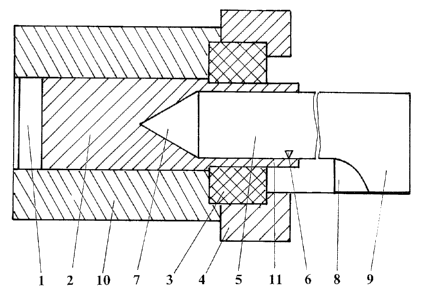Une partie des informations de ce site Web a été fournie par des sources externes. Le gouvernement du Canada n'assume aucune responsabilité concernant la précision, l'actualité ou la fiabilité des informations fournies par les sources externes. Les utilisateurs qui désirent employer cette information devraient consulter directement la source des informations. Le contenu fourni par les sources externes n'est pas assujetti aux exigences sur les langues officielles, la protection des renseignements personnels et l'accessibilité.
L'apparition de différences dans le texte et l'image des Revendications et de l'Abrégé dépend du moment auquel le document est publié. Les textes des Revendications et de l'Abrégé sont affichés :
| (12) Brevet: | (11) CA 2957453 |
|---|---|
| (54) Titre français: | EXTRUDEUSE POUR FABRIQUER DES TOLES PLANES |
| (54) Titre anglais: | EXTRUSION PRESS FOR PRODUCING FLAT SHEETS |
| Statut: | Octroyé |
| (51) Classification internationale des brevets (CIB): |
|
|---|---|
| (72) Inventeurs : |
|
| (73) Titulaires : |
|
| (71) Demandeurs : |
|
| (74) Agent: | MILLMAN IP INC. |
| (74) Co-agent: | AIRD & MCBURNEY LP |
| (45) Délivré: | 2018-10-16 |
| (86) Date de dépôt PCT: | 2014-10-07 |
| (87) Mise à la disponibilité du public: | 2015-04-23 |
| Requête d'examen: | 2017-02-07 |
| Licence disponible: | S.O. |
| (25) Langue des documents déposés: | Anglais |
| Traité de coopération en matière de brevets (PCT): | Oui |
|---|---|
| (86) Numéro de la demande PCT: | PCT/DE2014/000488 |
| (87) Numéro de publication internationale PCT: | WO2015/055160 |
| (85) Entrée nationale: | 2017-02-07 |
| (30) Données de priorité de la demande: | ||||||
|---|---|---|---|---|---|---|
|
L'invention concerne une extrudeuse servant à fabriquer des tôles planes à partir de profilés creux en magnésium ou en alliage de magnésium au moyen d'une tête de mandrin qui pénètre dans l'orifice de filière d'un outil d'extrusion. Le mandrin (5) est disposé de telle façon que sa tête (7) pénètre dans l'orifice de la filière depuis l'extérieur et la tête de mandrin (7) a la forme d'un cône.
The invention relates to an extrusion press for producing flat sheets from
hollow
sections consisting of magnesium or magnesium alloys, said press comprising a
mandrel head that protrudes into the impression die opening of an extrusion
die, the
mandrel (5) being arranged with its mandrel head (7) protruding into the
opening of the
impression die and said mandrel head being (7) conical.
Note : Les revendications sont présentées dans la langue officielle dans laquelle elles ont été soumises.
Note : Les descriptions sont présentées dans la langue officielle dans laquelle elles ont été soumises.

Pour une meilleure compréhension de l'état de la demande ou brevet qui figure sur cette page, la rubrique Mise en garde , et les descriptions de Brevet , États administratifs , Taxes périodiques et Historique des paiements devraient être consultées.
| Titre | Date |
|---|---|
| Date de délivrance prévu | 2018-10-16 |
| (86) Date de dépôt PCT | 2014-10-07 |
| (87) Date de publication PCT | 2015-04-23 |
| (85) Entrée nationale | 2017-02-07 |
| Requête d'examen | 2017-02-07 |
| (45) Délivré | 2018-10-16 |
| Date d'abandonnement | Raison | Reinstatement Date |
|---|---|---|
| 2016-10-07 | Taxe périodique sur la demande impayée | 2017-03-06 |
Dernier paiement au montant de 210,51 $ a été reçu le 2023-08-14
Montants des taxes pour le maintien en état à venir
| Description | Date | Montant |
|---|---|---|
| Prochain paiement si taxe générale | 2024-10-07 | 347,00 $ |
| Prochain paiement si taxe applicable aux petites entités | 2024-10-07 | 125,00 $ |
Avis : Si le paiement en totalité n'a pas été reçu au plus tard à la date indiquée, une taxe supplémentaire peut être imposée, soit une des taxes suivantes :
Les taxes sur les brevets sont ajustées au 1er janvier de chaque année. Les montants ci-dessus sont les montants actuels s'ils sont reçus au plus tard le 31 décembre de l'année en cours.
Veuillez vous référer à la page web des
taxes sur les brevets
de l'OPIC pour voir tous les montants actuels des taxes.
| Type de taxes | Anniversaire | Échéance | Montant payé | Date payée |
|---|---|---|---|---|
| Requête d'examen | 800,00 $ | 2017-02-07 | ||
| Rétablissement des droits | 200,00 $ | 2017-02-07 | ||
| Le dépôt d'une demande de brevet | 400,00 $ | 2017-02-07 | ||
| Rétablissement: taxe de maintien en état non-payées pour la demande | 200,00 $ | 2017-03-06 | ||
| Taxe de maintien en état - Demande - nouvelle loi | 2 | 2016-10-07 | 100,00 $ | 2017-03-06 |
| Taxe de maintien en état - Demande - nouvelle loi | 3 | 2017-10-10 | 100,00 $ | 2017-08-24 |
| Taxe finale | 300,00 $ | 2018-09-06 | ||
| Taxe de maintien en état - Demande - nouvelle loi | 4 | 2018-10-09 | 100,00 $ | 2018-09-06 |
| Taxe de maintien en état - brevet - nouvelle loi | 5 | 2019-10-07 | 200,00 $ | 2019-10-03 |
| Taxe de maintien en état - brevet - nouvelle loi | 6 | 2020-10-07 | 200,00 $ | 2020-10-01 |
| Taxe de maintien en état - brevet - nouvelle loi | 7 | 2021-10-07 | 204,00 $ | 2021-09-30 |
| Taxe de maintien en état - brevet - nouvelle loi | 8 | 2022-10-07 | 203,59 $ | 2022-09-08 |
| Taxe de maintien en état - brevet - nouvelle loi | 9 | 2023-10-10 | 210,51 $ | 2023-08-14 |
Les titulaires actuels et antérieures au dossier sont affichés en ordre alphabétique.
| Titulaires actuels au dossier |
|---|
| BRUHNKE, ULRICH |
| Titulaires antérieures au dossier |
|---|
| S.O. |